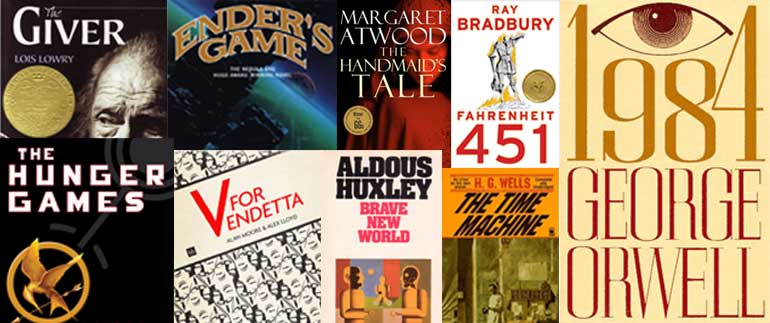Dystopian literature without a doubt has sealed its place as a prominent genre among juvenile and adult readers alike. The genre only continues to grow in popularity and diversity. “Young adult (YA) dystopian literature is a trend that is taking the nation by storm.
Since September 11, 2001, the genre has gained a strong backing from academics, authors, and YA readers; after Suzanne Collins’s The Hunger Games (2008), however, YA dystopian literature has become the forefront of teen reading,” (Ryan 1).
However, this popularity among readers poses the question, what exactly makes this genre so appealing to readers? This may be due to the relatability of the themes and characteristics common in dystopian literature and how they reflect the real world. “Constant surveillance, oppressive ruling regimes, lack of freedom, and forced conformity are all aspects of adolescent life that teenagers deal with on a daily basis,” (Ryan 2). These themes and conflicts that are prevalent in dystopian literature not only reflect aspects of life for teenagers but also are implicative of the real world.
To fully comprehend how dystopian literature reflects the real world, one must understand what a dystopia is; per English instructor Terri Chung of North Seattle Community College, a dystopia in the literary sense is, “A futuristic, imagined universe in which oppressive societal control and the illusion of a perfect society are maintained through corporate, bureaucratic, technological, moral, or totalitarian control.”
Despite dystopian literature taking the conditions of the real world and spinning them to extremes, the themes and elements present in dystopian societies are still applicable to real-life society. The Hunger Games and the other books of the trilogy are some of the most popular books in the dystopian genre, and while this may be largely due to the romantic elements of the story, its success can also be derived from the relatability of the themes touched on in the story.
In the case of The Hunger Games, these themes include but are not limited to social-class divisions, outlandish beauty standards and ideals, and ideas of what is considered entertaining in the media.
In the story, the districts are divided based on the goods or commodities that they provide for the Capitol. The importance of the good a District provides along with simply how close it is to the Capitol determines the quality of life in that District and how wealthy its population is.
Although the Capitol likes to push that all the districts are equal, the clear-cut social-class divisions from district to district are too glaring to gloss over. This drastic division in the quality of life and the government’s message of equality is an almost obvious nudge at the state of the real world and touches on the theme of equality versus equity.
For example, right here in America, which claims to be the land of equal opportunity, one can see the obvious distinctions between places such as Compton and Beverly Hills with the cities having a per capita income of roughly $13,000 and $85,000 respectively according to the U.S. Census Bureau.
In addition, the gap between the Capitol and the Districts reflects the gap between the richest one percent and the rest of the population. In an article from BBC News, Oxfam, a confederation of 19 organizations worldwide in a fight against poverty, “… calculated that the richest 62 people in the world had as much wealth as the poorest half of the global population.”
In The Hunger Games, the people of the Capitol are described as having outlandish features about them cosmetic-wise. For example, one of Katniss’ two stylists, Venia, is described as having, “… aqua hair and gold tattoos above her eyebrows.” The citizens of the Capitol are always changing their facial and body features to match the newest Capitol trends even to the point of going through body modification procedures to keep up with these trends and be considered beautiful, handsome, etc.
However, not just in the story but also in the real-world people are willing to go to great ends to keep up with all the latest beauty trends; this includes purchasing products or performing actual body modification procedures all for the sake of being considered pretty. Additionally, in the weeks leading up to the actual Games, the tributes are put through a thorough cleaning and grooming process and are dressed up in the fanciest Capitol wear even though they are about to be sent to their deaths.
This reflects today’s society because people of all ages today still spend vast sums of money on beauty products and body modification procedures; in fact, the beauty and cosmetics market is worth about $62 billion as of 2016 per MarketResearch.com. Nevertheless, things get worse than just over-indulging in cosmetics and beauty products in the Capitol and in reality.
Although a group of 24 teenage children are being sent to their imminent deaths, the citizens of the Capitol view the Hunger Games as nothing more than a show; the Capitol simply shrugs it off and chalks the practice up to sport. This twisted sense of what is considered entertainment, while not quite exhibited to this degree in real life, can be seen easily in today’s media.
Television broadcasts such as UFC, where opponents brutally beat down each other in a bloody brawl, and almost every reality television show, in which people draw entertainment from the drama and conflict in famous people’s lives, can be seen all too clearly in today’s society. In an article discussing the negative effects of reality television on adolescents, a Penn State Psychology student wrote, “Several adolescent television shows these days are full of fun, partying, fighting, and drama.
Many of these shows can be categorized as reality television shows.” Another aspect of the games in relation to television is the tributes having to put on acts (e.g. Katniss and Peeta’s love) in order to get sponsors to increase their chances to live in the Games. This reflects the wave of adolescents today that think that they can “make it big” by simply doing something over-the-top and crazy to get discovered and become famous overnight. While it is a means of survival in The Hunger Games, in the real world it leads to undriven children who aren’t willing to really work for anything because they’re holding out for their “big break.”
In conclusion, several of the themes and principles of dystopian societies can be related back to the real world. Issues faced in dystopian societies are issues faced by not only young adults but people of all ages, albeit not quite to the same extent as in dystopian literature.
In The Hunger Games, themes such as social class divisions, beauty standards, and ideas of entertainment are all present in today’s society, and this relatability is part of what makes the book series so successful. Perhaps this is where the allure of dystopian literature stems from, people can see reflections of their own lives in stories like The Hunger Games.
The connections that can be drawn from the story to the real world allow people to better understand the world they live in and how to keep it a better place than the broken, dysfunctional world they dove into.




Wish me luck on my exam essay for English 🙂